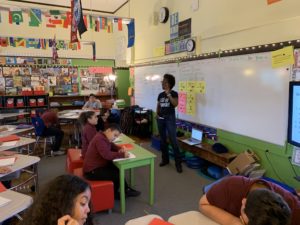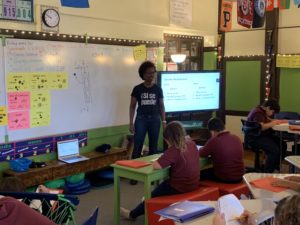Eighteen 6th graders work in small groups or pairs scattered around a large rectangular-shaped classroom. Two students are at the front of  the room, near the rug, working independently seated in reclining chairs with their feet on the chair and their knees up to their chins where the math work is perched. Another student has on noise-canceling earphones and works on a computer. One group of four boys is at the back of the room around a rectangular table working with a teacher who I learn is a special needs educator. In addition to the expansive way that students are engaged in the class, there is a rich diversity of language backgrounds–culture and race is also noticeable, but maroon t-shirts and khaki pants unify everyone into one class. I feel like I’m in a workshop, not a classroom. No overhead fluorescent lights are turned on. The large windows in the back of the room let in natural light and fairy lights twinkle around the whiteboard. Lamps are scattered about the room bringing in soft light. Water and Kleenex is by the door. Posters and books line the walls. All are of people of color. One poster reads “Empathy: Put yourself in their shoes.” Another I particularly love reads, “I want to hire employees who can’t do math—said NO boss ever!!” The class poster, written by the students, is prominently displayed. “Habits of a Good Mathematician” reminds students to “Believe we ALL matter, Stay on task, Come to class prepared, Best effort, Show work/Check work, Explain work.”
the room, near the rug, working independently seated in reclining chairs with their feet on the chair and their knees up to their chins where the math work is perched. Another student has on noise-canceling earphones and works on a computer. One group of four boys is at the back of the room around a rectangular table working with a teacher who I learn is a special needs educator. In addition to the expansive way that students are engaged in the class, there is a rich diversity of language backgrounds–culture and race is also noticeable, but maroon t-shirts and khaki pants unify everyone into one class. I feel like I’m in a workshop, not a classroom. No overhead fluorescent lights are turned on. The large windows in the back of the room let in natural light and fairy lights twinkle around the whiteboard. Lamps are scattered about the room bringing in soft light. Water and Kleenex is by the door. Posters and books line the walls. All are of people of color. One poster reads “Empathy: Put yourself in their shoes.” Another I particularly love reads, “I want to hire employees who can’t do math—said NO boss ever!!” The class poster, written by the students, is prominently displayed. “Habits of a Good Mathematician” reminds students to “Believe we ALL matter, Stay on task, Come to class prepared, Best effort, Show work/Check work, Explain work.”
That is exactly what goes on during my short visit to Ms. Arnold’s classroom. Ms. Arnold is dressed in jeans and a black t-shirt with “Be Bold” emblazoned across the front. She moves like a trained dancer, lithely jumping from one end of the room to another, seeming to pop up at every table and corner just as a student or group of students needs her. “This is a very challenging problem,” she tells her class. “You have what it takes to solve it! We have to learn to lean into it.” I notice one table where I think I heard an anxious groan escape from the student. I walk over there. “Do you know how to do this?” I ask the two students. One student, who tells me his name is Walter, immediately begins to explain the problem to me. The challenge is to find the area of the rectangle INSIDE the larger rectangle. I find myself freezing inside. I remember these problems. They ARE hard. I turn to the other student to see if he has made progress. He shakes his head moodily. “Maybe your table partner can help?” Walter begins to explain his process. Maybe this is going to help, but I’m not sure… The boys in the back are hard at work with their teacher. “Wait, show me how you did that?” one asks the other. Ms. Arnold has suddenly hopped back to the front of the room. She interrupts the focus of the class. “I’m excited you’ve embraced the struggle of this problem. Are you ready to show your work?” Someone calls out, “Two more minutes.” And the timer goes back on and Ms. Arnold goes to help another student. Two minutes pass. “Okay, who’s going to be a courageous person and show us how you did the problem?” Ms. Arnold asks one student, but she shakes her head, “No.” Many other hands shoot up eager to share. Ms. Arnold asks Walter to show his process. He goes up to the board and explains how he solved the problem. Ms. Arnold asks for applause for Walter. “Who else wants to show how they did the work?” A student gets up and asks if she can erase Walter’s work so she can start again. “I want to draw the problem.” Ms. Arnold suggests she draws next to Walter’s work. She masterfully draws one rectangle inside of another. She writes out how she got the area of the bigger rectangle. Then she turns to the class and says, “The smaller rectangle is half –so that’s the answer.” Ms. Arnold asks how she figured that out. “I can see from the drawing that it’s half.”
 “Ah, that’s fascinating. You visualized it. You made an approximation. But that’s not exact math and in math we want to be absolutely exact. That was a great idea. Can anyone else show us exactly how you could solve the problem?” The boys in the back volunteer Marco. He gets up and fist pumps his seat mates as he moves to the board to show his process. Ms. Arnold reminds him to wait until he has the class’ attention and respect. Marco walks the class through his process. “So, I was looking at this and it looked like the box that wasn’t shaded was bigger. I multiplied the two sides and got 48 centimeters. Then, I took the two smaller shapes, and did the same thing and then I added those two numbers and I got 140 and then I subtracted by 80 and got 60.” The class breaks into spontaneous applause.
“Ah, that’s fascinating. You visualized it. You made an approximation. But that’s not exact math and in math we want to be absolutely exact. That was a great idea. Can anyone else show us exactly how you could solve the problem?” The boys in the back volunteer Marco. He gets up and fist pumps his seat mates as he moves to the board to show his process. Ms. Arnold reminds him to wait until he has the class’ attention and respect. Marco walks the class through his process. “So, I was looking at this and it looked like the box that wasn’t shaded was bigger. I multiplied the two sides and got 48 centimeters. Then, I took the two smaller shapes, and did the same thing and then I added those two numbers and I got 140 and then I subtracted by 80 and got 60.” The class breaks into spontaneous applause.
Ms. Arnold asks again for everyone to applaud again. “Applause for all of your attentiveness and respect!” There’s lots of excitement as Marco sits back down. He has done an excellent job explaining his work. Ms. Arnold is beaming. “Who tried the problem, even if you didn’t get it right?” Everyone’s hands go up. “You really leaned into this problem. Kiss your brains for how hard you worked!” Everyone does just that- kisses their fingers and then taps their heads.
I’ve been to GPA dozens of times; I’ve given PD workshops there; I’ve been in classrooms visiting with teachers; I’ve gone to meetings there; I’ve brought many visitors through and I never cease to delight in the morning or afternoon I spend there. GPA is, in a word, delightful. The old style school house which sits in a residential neighborhood gleams with polished floors, shiny clean windows, student art and academic work everywhere, and in the principal’s office there’s a wall with everyone’s MCAS test scores. The outdoor play area is equally inspirational with a pollinator garden, a vegetable garden, an outdoor classroom area and wonderful places to run, play, jump and build. This is a school that celebrates joy and movement, making and learning in many different forms and ways. It’s a school that celebrates and promotes deep family connection as well as the critical role of partners. It is proudly a full-service school which makes it a full-service community. That means it’s open for breakfast, lunch and dinner and sometimes when I’m there every classroom is filled with adults studying ESL. It’s also a school that proudly celebrates being a full inclusion school which means that all classrooms have students with learning disabilities and students who are progressing more “normally.” Normally is in quotes since at Gardner everyone is unique and treated that way. Normal is a state of mind. GPA is also in the 16th percentile for test scores but principal Erica Herman is clear about what that means to her and her students, teachers and families. “Of course, we have more work to do. We are always evolving and improving. But how is it that we are the same as a school in the suburbs where the needs of students and families are so vastly different? Do we ever truly tell that story? We do kids’ laundry here. We have a washer and dryer. We serve three meals a day. We have countless homeless students. And I don’t say that as an excuse. We still hold our students to high standards. But our students have to work a lot harder and with a lot fewer resources that the kids in my own childrens’ suburban schools. That story is not told.” Today, I want you to see the superb teaching and learning at Gardner Pilot Academy. I want you to feel the respect and love that exists between students and teachers. I want you to sense the creativity, resilience and comradery of its students. If all young people could go to schools that believe so intensely in being a community where everyone is accepted, and where everyone is working together to meet the needs of all young people, our society would be a much more hopeful place. I believe that GPA graduates have the skills and knowledge to enter high school and hopefully find paths to success in their lives and communities. I am a fan of this school and I encourage you all to visit!
